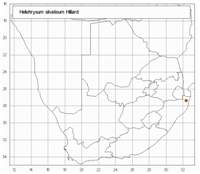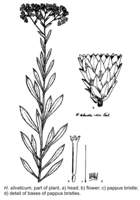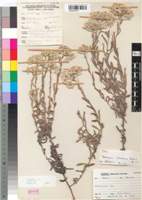Origin of name:
silvaticus = pertaining to the woods, growing wild
Diagnostic characters:
White bractsBranched inflorescences with terminal clusters of headsMedium-sized flowers
Description:
Perennial herb up to c. 400 mm high, sparingly branched, branches thinly grey-woolly, leafy particularly above. Leaves c. 15-40 x 1.5-6 mm, slightly smaller upwards, elliptic-lanceolate, apex acute, mucronate, base narrowed, sessile, both surfaces thinly grey-woolly. Heads homogamous, turbinate-campanulate, c. 4 x 4 mm, many in small corymbose panicles terminating the branches. Involucral bracts in c. 5 series, graded, loosely imbricate, inner about equaling flowers, bases silvery, translucent, tips opaque white, acute, not radiating. Receptacle with fimbrils equaling ovaries. Flowers c. 20-30. Achenes 0.5 mm long, glabrous. Pappus bristles many, about equaling corolla, scabridulous, bases cohering strongly by patent cilia, some light fusion as well.
Flowers in June and July; rarely collected.
Distribution:
Growing in open woodland or grassland on sandy soils. Recorded from the Mozambique coastal plain and its extension southwards into northern Zululand (Tongaland).
Savanna Biome.
Taxonomy:
Literature:
Helichrysum silvaticum Hilliard in Notes R. Bot. Gdn Edinb. 32: 361 (1973), Compositae in Natal 192 (1977).
Type:
KwaZulu- Natal, Ubombo distr., Makatini Flats, Strey 5287 (NU, holo.; PRE iso.).
Synonym(s):
Vouchers:
Gerstner 3467 (BOL, K); Junod 2912 (G).


